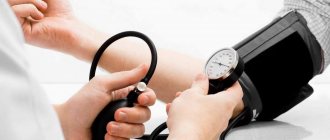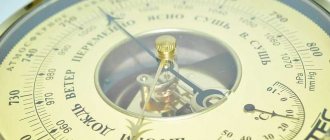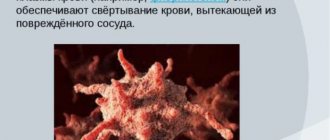Unusual numbers on a tonometer can make a person panic and look for ways to immediately restore standard blood pressure (BP). Although sometimes there is no particular reason to panic, depending on what indicators of the device you consider normal.
For example, if the working (and therefore the norm) blood pressure was 120 to 80 mmHg, then a decrease in the indicator to 110 mm can be considered an optimal permissible drop.
As a rule, the “lower” pressure also drops at the same time, but such synchronicity is not always observed. And if, for example, the pressure is 110 over 90, what does this mean, should you worry and take measures to stabilize it? To answer these questions, let’s remember what the concept of blood pressure includes and what the double number means as a result of the measurement.
Concept of blood pressure and pulse difference
Blood pressure is the force with which blood flow presses on the walls of blood vessels - arteries - during certain phases of the cardiac cycle.
The first value in the blood pressure measurement results corresponds to systolic blood pressure (SBP), that is, the force of pressure on the vessels at the time of systole. Systole is the phase of the cardiac cycle when the heart, filled with blood, contracts and pushes this blood into the arteries.
The second, smaller value reflects the strength of diastolic pressure (DBP), more precisely, vascular tone at the time of diastole - the phase during which the heart muscle relaxes, the valves close and the heart receives a new “wave” of blood.
The difference between higher and lower blood pressure readings is called pulse pressure or pulse difference. Its norm is 30–50 mm, but can deviate up to 20 units in both directions. If the pressure is 110 over 90, then the pulse difference is 20 mm. In some cases, the pulse difference has diagnostic and prognostic significance.
Blood pressure norms
Why does the “upper” pressure decrease and the “lower” pressure increase?
The classic blood pressure value is 120 at 80 mmHg. Art. has long ceased to be the only guideline for determining deviations from the norm.
Reduced systolic pressure indicates weak tone of the vascular walls or weak cardiac output, which can affect oxygen metabolism and nutrition of all tissues.
What does elevated diastolic blood pressure mean? The level of “lower” pressure depends on the tone of peripheral vessels, in particular the state of the renal capillaries. This means that the greater the resistance of the small vessels of the periphery to the blood, the higher the diastolic pressure.
What does it mean if blood pressure is 110 at 90 mm Hg? Art.?
If the systolic reading is not considered low when the pressure is 110 over 90, what does that mean? Here we are dealing with optimal SBP and uncritically elevated DBP.
Most specialists do not see anything pathological in such blood pressure values and call the pulse difference 20 mm Hg. st is quite normal, especially for patients in adolescence and young adulthood. Such indicators may be the result of fatigue or lack of sleep.
If you have a headache
There are cardiologists who are confident that elevated diastolic blood pressure values are simply underestimated and suggest treating the condition as isolated diastolic hypertension. Especially if, with a pressure of 110 over 90, headaches and other hypertensive symptoms significantly worsen the patient’s quality of life.
These experts see the causes of isolated diastolic hypertension in the following factors:
- various heart disorders;
- atherosclerotic lesions of arteries;
- tumor diseases;
- disorders in the musculoskeletal system;
- fluid retention in the body (often observed in pregnant women);
- increased activity of the thyroid gland;
- overweight patient.
Doctors see measures to stabilize blood pressure in such cases as eliminating the underlying diseases.
If the pulse rate is increased
If the pressure is 110/90 and the pulse is 110 beats per minute, then we can talk about the development of tachycardia, which can also be either an independent cardiac disorder or a symptom of other diseases. This means that without qualified diagnostics the causes of this condition cannot be determined. Especially if these blood pressure values were not discovered just once, but appear regularly.
A considerable number of people feel healthy with a pressure of 110 over 90. But a pulse of 110 signals that the pressure may be optimal, but the heart rate indicates an attempt by the heart to increase stroke volume, which means that there are disturbances in the functioning of the system.
What does a lower pressure of 90 mean?
The problem of blood pressure and its deviations from the norm upward or downward is one of the most pressing today. When measuring using instruments, two results are obtained - upper and lower pressure. With hypertension, both indicators increase approximately equally. However, often with normal or slightly increased upper pressure, the lower one “jumps” much more.
Arterial (blood) pressure
Blood pressure (BP) is the degree of pressure with which blood presses on the vascular walls. The upper (systolic) is the pressure that occurs when the left ventricle of the heart contracts (systole), the lower (diastolic) - when it relaxes (diastole). Normal pressure is considered to be from 110/70 to 130/90 mmHg.
Upper pressure is determined by the force of heart contraction, which is why it is called “cardiac”. Lower pressure depends on the state of the vascular system, as well as on the functioning of the kidneys. The kidneys synthesize a substance - renin, which affects vascular tone and, accordingly, lower pressure, sometimes called “renal”.
If the lower pressure is 90 and the upper pressure is 130 or higher, this is the upper limit of normal, and sometimes a tendency to develop hypertension. An increase in blood pressure can occur during physical activity, emotional experiences and stressful situations. If the increase is persistent, most likely this is evidence of the onset of a disease - hypertension.
The cardiologist said that a cure for hypertension has finally appeared.
Diastolic (bottom) pressure
The norm is from 70 to 90 mm Hg. Art. If the diastolic pressure remains at 90 for a certain time, what does this mean? With a simultaneous increase in upper pressure, the initial stage of hypertension is possible. With an isolated increase in diastolic pressure, an examination should be carried out, since this condition can be caused by various factors, primarily the following diseases:
- renal pathologies;
- disruption of the adrenal glands;
- endocrine diseases (dysfunction of the thyroid gland, pituitary gland);
- problems with the spine (osteochondrosis, herniated discs);
- atherosclerotic vascular lesions;
- heart defects or tumors.
- traumatic situations and chronic stressful conditions;
- alcohol abuse;
- use of stimulants (medicines, dietary supplements, energy drinks);
- excessive smoking;
- fluid retention caused by the habit of overeating and frequent errors in the diet (fried, fatty foods, pickles, smoked foods, canned food).
The dangers of high diastolic pressure
Depending on the reasons causing a persistent increase in lower pressure, complications of existing diseases and negative consequences of an unhealthy lifestyle are possible. In the absence of treatment for the underlying disease or a frivolous approach to the need for treatment, the disease will progress, posing a threat to the vital functions of the body.
Is this condition dangerous?
Prognoses for such a condition, when the pulse difference is only 20 units, can only be discussed in the light of the main pathologies found in the body that have led to an imbalance in blood pressure. Here attention should be paid to other clinical manifestations - the pulse and general well-being of the patient. For example, if the pressure is 110 over 90, the pulse is 90 (within acceptable limits), and the patient does not feel sick, then this condition can be classified as normal.
You should be concerned if the indicated blood pressure values are associated with a deterioration in the patient’s condition and the manifestation of symptoms characteristic of diastolic hypertension:
- nosebleeds;
- nausea, vomiting;
- causeless anxiety;
- cold sweat;
- difficulty breathing, discomfort and pain in the sternum (the central bone of the chest);
- localization of headache in the back of the head;
- dizziness, tinnitus, flickering of spots before the eyes;
- if the pressure is 110 over 90 and the pulse is 110.
The causes of such symptoms at the blood pressure levels under consideration may be the dangerous pathologies discussed above and requiring serious treatment.
What to do?
If you are concerned about any of the above clinical manifestations, and if the pressure is 110 over 90, what should you do in this case? There is only one answer - go to the doctor and find out the cause.
Non-medicinal methods include:
- dieting - limiting daily consumption of table salt, fatty, smoked, fried and sweet foods, tonic drinks;
- getting rid of bad habits;
- physical therapy and daily morning exercises, designed taking into account the patient’s health characteristics.
Drugs (usually diuretics) are rarely used in such cases, since active treatment of isolated diastolic hypertension can lead to systolic hypotension. This means that the patient’s cardiovascular system will be forced to adapt to an unusual operating mode and spend energy on a compensatory response to the lack of blood supply, which cannot be called an adequate solution to the problem. The selection of medications and their dosage can only be entrusted to a specialist.
What to do if the upper data is lowered?
If the pressure is 110, what should I do? If you have started monitoring your blood pressure and have occasionally noticed a decrease in the upper readings, then by following some simple tips you can harmonize the body’s functioning:
- In the morning, drink natural coffee with sugar (better before 12 o’clock, while the body is awake).
- Monitor your diet (it should be regular and balanced).
- Be physically active, even if sedentary - get up and take short but active breaks.
- Walk in the fresh air for at least 30 minutes. Daily.
- Stick to a sleep and rest schedule.
- Tone the body with a contrast shower.
- Don't overheat.
If your job causes you constant stress, learn relaxation techniques and use them regularly. Do not neglect procedures such as massage, swimming in the pool, quality spa relaxation, and regular changes of environment.
Low blood pressure may not cause discomfort, however, if there are foci of infection in the body, weakened immunity and stress can cause complications. That is why it is necessary to promptly get rid of viral and bacterial infections, such as:
There are a huge number of traditional medicine recipes that allow you to correct hypotension without side effects. Including the following foods in your diet helps increase blood pressure: coffee, honey, ginger, lemon, celery, aloe.
Important! It is not recommended to take medications on your own, even if they have helped someone. It is better to consult a doctor so that he can consider your case individually.
If at a pressure of 110 over 80 you do not feel any discomfort, then it makes sense to bring the body back to normal in a natural way - walk more, eat rationally, follow a work-rest schedule, strengthen the immune system and cure infections in a timely manner. This will allow your blood pressure to normalize soon. Take care of yourself and be healthy!
Useful video
From the following video you can learn how to correctly measure blood pressure at home:
https://youtube.com/watch?v=K5xGdM6yHHc
Blood pressure 110 to 90 mm Hg. Art. Few people will be happy. It is quite an alarming signal, because any deviation from the norm should cause concern. If the readings increase, it means that arterial hypertension is developing, but if the tonometer numbers decrease, this indicates hypotension. It is important to know what pressure 110 over 90 means, what are the reasons for such an increase in blood pressure. This is necessary in order to properly assist the patient and prescribe adequate therapy.
Norms of blood pressure values
According to statistics, about 7 million people die every year due to diseases associated with high blood pressure. About 67% of people suffering from hypertension are unaware of problems with blood pressure.
Blood pressure is represented by the force with which the blood presses on the vessels. This indicator depends on the volume of blood that the heart is able to distill in a minute, the capabilities of the heart muscle, and the condition of the blood vessels. Blood pressure and pulse are considered individual criteria. These important health indicators depend on various factors. One of them is age. Each age group has its own blood pressure norm.
In an adult, if he is healthy, blood pressure is normally 120 per 80 mm Hg. Art. Slight fluctuations in the tonometer readings in one direction or the other are also considered normal. Hypertension is characterized by an increase in blood pressure, and hypotension is characterized by a decrease in blood pressure.
What does pressure 110 over 90 mean?
Sometimes doctors record a decrease in the difference between systolic and diastolic blood pressure. Blood pressure of 115 over 90 may be normal or indicate certain disorders in the body. The relative norm may be 110/90 for some people who regularly exercise. Upper or lower pressure affects a person’s well-being.
A condition in which the upper reading is below 140 mm Hg. Art., and the lower one is above 90 mm Hg. Art., experts call isolated diastolic hypertension. When diastolic pressure is 90-110 mmHg. Art., a person notices changes in well-being. He is worried about blurred vision, shortness of breath, headaches, and nosebleeds.
When diastolic blood pressure increases to 90 mm Hg. Art. blood vessels lack blood. A further increase in lower pressure can provoke complete closure of the vascular lumen. This will have a number of negative health consequences.
High diastolic pressure is dangerous:
- thinning of arterial walls;
- the formation of atherosclerotic plaques, interfering with normal blood flow.
Researchers have found that atherosclerotic plaques almost never form on the walls of veins. This is explained by the fact that the walls of these vessels do not consist of muscle tissue, like arteries. Veins usually function normally and do not experience the same pressure as arteries.
Doctors include high blood pressure on the list of the main causes of atherosclerosis. For this reason, they began to pay more attention to the diastolic indicator of the tonometer. According to the WHO classification, hypertension, taking into account the lower pressure indicator, is divided into 3 degrees:
- 1st degree. The diastolic indicator of the tonometer is 90 – 100 mm Hg. Art.
- 2nd degree (101 – 110 mmHg).
- 3rd degree (110 and above).
What does high lower pressure mean?
High lower pressure is a symptom that requires investigation. Especially if this condition appears suddenly and is accompanied by a deterioration in general health. A person’s pressure (upper and lower) reflects different factors. Diastolic (lower) is determined at the moment when the ventricles of the heart relax, upper - a response to the resistance of the vascular walls. What does lower pressure show? Diastolic pressure increases if fluid retention occurs in the body. For this reason, the walls of blood vessels swell and the lumens become narrower. If you have high lower blood pressure, avoid salty foods. In particular, do not eat bouillon cubes, chips, or other products containing monosodium glutamate. Also try to add less salt to cereals, soups and other home-cooked dishes. Use products to get rid of excess fluid accumulated in the body.
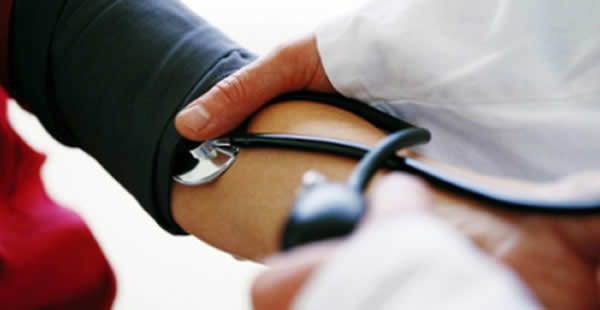
What to do?
You need to do the following: regularly record your blood pressure readings in a notebook; during the day - monitoring of pressure and ECG; undergo an ultrasound of the heart and kidneys; biochemical blood test, general blood and urine analysis; thyroid examination; undergo Doppler examination of cerebral vessels. Based on the data obtained, the doctor will be able to make the correct diagnosis. After all, high lower pressure is not a cause, but a consequence of any disease. And eliminating the symptom will not solve the underlying problem.
First of all, the underlying disease that caused the increase in blood pressure is treated. Antihypertensive drugs that have a diuretic effect are also taken. Hypothiazide, Triampur, Indapamide and Veroshpiron are commonly used. If the desired effect is not achieved, calcium and beta blockers are used - Atenolol, Metoproplol and Verapamil. As maintenance therapy, you can use Doppelhertz or Bittner balms.
Classification
The degree of the disease is classified depending on the lower pressure readings. The first stage is characterized by values in the range from 90 to 100 mmHg. For the second - from 100 to 110. For the third - more than 110.
Source
Symptoms of high lower pressure
● Almost always, isolated diastolic pressure, due to the absence of complaints and obvious signs of illness, is detected by chance during routine medical examinations, a visit to the clinic, treatment for another disease, etc. Moreover, due to the absence of symptoms, few people are alarmed, suggesting that only upper high blood pressure poses a danger.
● After a few days, having measured the pressure again, the patient, on the advice of his relatives, begins to take antihypertensive drugs (lowering blood pressure). As a result of such thoughtless self-medication, the upper pressure sharply decreases, the levels of which were normal.
● High lower pressure is very dangerous because the heart is constantly under tension, does not relax, and blood flow in its muscles is disrupted. Structural changes occur in the walls of blood vessels (they become more rigid), and their permeability is impaired. After some time, pathological changes progress, become irreversible and lead to changes in the heart muscle and the formation of blood clots.
Treatment of high lower pressure
● Starting with this important section of the article, I want to warn those people who decide to self-medicate. The diagnosis of “Isolated diastolic pressure” indicates a very serious disease that requires the intervention of many specialists. Therefore, if you have started conservative treatment in a clinic, in agreement with your doctor, you can use the traditional medicine recipes given below as additional treatment.
● Drug treatment is successfully complemented by the use of sedative and hypotensive medicinal herbs - peony, valerian, motherwort, which have a beneficial effect on the endocrine and cardiovascular systems by reducing the release of hormones and eliminating stress tension.
● Motherwort has a mild diuretic property and increases the strength (not the number!) of heart contractions. Pour two tablespoons of raw material into two glasses of boiling water and let it brew for 15-20 minutes. Drink in 3-4 doses during the day and before bed.
● Since ancient times, the beneficial properties of valerian have been known, which, in addition to the above, is also indicated for diseases of the thyroid gland, weakening the excitability caused by its hyperfunction.
● In the evening, pour a glass of boiling water over a tablespoon of valerian roots in a thermos. In the morning, when you wake up, strain the infusion and take a tablespoon after meals 3-4 times a day. Attention: taking valerian preparations for more than 1.5-2 months in a row is not recommended.
● A good sedative effect is provided by the evasive peony. Boil a tablespoon of peony in a glass of boiling water for 5 minutes, strain. 1 tbsp. l. before meals three times a day. Also drink pharmaceutical peony tincture three times a day, a teaspoon. The duration of treatment is one month.
● For high lower blood pressure caused by kidney disease, diuretic teas and herbs are very effective. Grind and mix one tablespoon each of sage and St. John's wort, two tablespoons of oregano and five tablespoons of motherwort. Pour two glasses of boiling water over two tablespoons of the mixture and leave for 20 minutes. Drink half a glass three times a day 20 minutes before meals.
● Another fee with the same effect. Mix, after crushing, 1 tbsp. l. sweet clover herbs, mint and shepherd's purse, two tbsp. l. licorice roots and 4 tbsp. l. dried herbs. The procedure for preparing and taking the infusion is similar to the previous recipe.
● Alternate collection every two months. Remember that herbal treatment is long-term, but effective, unlike chemical treatment.
● A very useful drink is made from lingonberry juice, which has not only a calming, but also a diuretic effect. Pour one and a half glasses of boiled water into half a glass of lingonberry juice and add a spoonful of honey. Drink everything in 3-4 doses after meals.
● Important advice. Every patient with high blood pressure, like any other hypertensive patient, needs to remember the following: the disease is aggravated by excess weight, smoking, excess salt, and frequent stress. LEAD AN ACTIVE SOBRIETY LIFESTYLE!
Source
liveinternet.ru>
Reasons for increased lower pressure
The causes of diastolic hypertension are the following conditions and diseases:
- atherosclerosis. This pathology is often recorded in people with increased lower blood pressure. The presence of this disease indicates problems with the synthesis of renin (an enzyme that is responsible for blood pressure). In this case, it is important to monitor vascular tone;
- dysfunction of the adrenal glands and thyroid gland;
- hereditary factor;
- kidney dysfunction, which is accompanied by fluid retention. Fluid levels in the body are controlled by the kidneys. This work is directly affected by hormones. An imbalance of water and sodium ions is accompanied by a dilution of the content of this chemical element and the accumulation of water. Most often, water is retained in the body during pregnancy, overeating, menstruation, allergies, and during the summer heat;
- physical inactivity (sedentary lifestyle);
- excess weight;
- unhealthy lifestyle (bad habits, poor diet, emotional breakdowns, lack of rest);
- spinal canal stenosis. This pathology is provoked by a narrowing of the spinal canals. It is more often recorded in older people. Stenosis also occurs in young people (this disease can be congenital). Its development is indicated by pain in the lumbar region and spine. She can kick into the leg. The pain syndrome occurs suddenly and intensifies with continued movement.
There are also a number of features of increasing lower blood pressure for different categories of patients:
- In women, high diastolic pressure can cause menopause, pregnancy, hormonal imbalances, increased emotional levels, excessive weight, and exhausting diets.
- Increased lower blood pressure is allowed in young people, as well as professional athletes.
- In men, high diastolic blood pressure is often caused by obesity, a sedentary lifestyle, smoking, stress, heart disease, and alcohol abuse.
High diastolic pressure becomes a symptom of certain diseases only at further stages of development. Patients rarely notice the primary stage of hypertension. Even when undergoing a routine examination or visiting a specialist for another reason, it is difficult to establish arterial hypertension. At the onset of the disease, signs may be completely absent or general in nature. People often attribute poor health to other illnesses.
Isolated diastolic hypertension has symptoms similar to the general symptoms of chronic hypertension. The patient experiences rare dizziness and increased heart rate. Shortness of breath also appears after walking up the stairs or running.
Let us indicate the main signs of hypertension:
- spots before the eyes (black dots);
- headache;
- impaired vision;
- cardiopalmus;
- drowsiness, apathy, irritability;
- chills, numbness of fingers;
- swelling of the face;
- pressure surges;
- sweating
If the pressure is 110 over 90, it is necessary to consult a specialist if a number of symptoms appear: severe aching headache, cold sweat, attacks of nausea, vomiting, high pulse, intermittent breathing, nosebleeds, tinnitus, a feeling of stiffness in the chest area.
It is important to know what to do if blood pressure rises to 110 to 90 mmHg. Art. These numbers can be normalized. To do this, you should adjust your usual lifestyle. The main recommendations of experts are presented in the following points:
- Providing the body with adequate rest with optimal work and sleep patterns.
- Losing excess weight. It is important to achieve an optimal body mass index (18.5 – 25). This indicator is recognized as follows: mass (in kilograms) divided by height (in meters) squared.
- Practice moderate physical activity.
- Rejection of bad habits. It is necessary to exclude the consumption of alcoholic beverages or reduce feasts to a minimum. Smoking is also excluded.
- Dieting. It is necessary to exclude sweets, flour products, smoked foods, and fatty meats from the diet. You should limit the amount of salt consumed and spicy seasonings in food.
- Elimination of stressful situations. If you can’t completely remove stress, you need to learn how to properly relax after it. You can try to master meditative practices. If necessary, the patient can also contact a psychologist.
When the patient’s clinical picture is 110/90 mmHg. Art. indicates the development of diastolic hypertension, the doctor prescribes a special course of drug therapy.
Important: Independent choice and use of hypotonic drugs will not bring any benefit. This approach to treatment is dangerous for the development of severe hypotension, in which the low level of upper pressure significantly decreases. You need to know what to drink if you have diastolic hypertension without harming your health.
Selecting the correct treatment regimen and clarifying the dosage of medications with antihypertensive effects should be carried out by a qualified specialist. Medicines used:
- diuretics;
- ACE inhibitors;
- beta blockers;
- calcium antagonists;
- angiotensin II antagonists.
Traditional medicine is also used to normalize diastolic blood pressure. When blood pressure is 110 to 90 mm Hg. Art. The following methods help:
- removing excess fluid from the body through diuretics based on medicinal plants;
- strengthening the walls of the arteries, which is achieved through the introduction of vegetable juices (beetroot, carrot), blueberry compotes, viburnum, chokeberry, lingonberry into the daily menu;
- restoration of the emotional background is possible by taking natural medicines that can have a sedative effect (melisa, mint).
If you do not carry out a therapeutic course at a pressure of 110 to 90, the underlying disease will worsen. The following serious consequences may develop: kidney failure, heart attacks, heart failure, strokes, vision problems.
When measuring pressure with a tonometer, two numbers are obtained - the upper (systolic) and lower (diastolic) reading. An increase in only one of them, while maintaining the other indicator within the normal range, is called systolic or diastolic hypertension, respectively. A pressure of 110 over 90 is diastolic hypertension, which requires detailed examination and treatment.
Pressure 110 over 80 – what does it mean and what symptoms to look out for
Doctors use blood pressure to determine a person's health status. Indicators of 120 to 80 are considered normal for almost all adults. In some cases, blood pressure may change, this depends on both external and internal factors. A pressure of 110 over 80 can be either normal or pathological. It all depends on the individual characteristics of the patient.
Blood pressure 110 over 80 - what does this mean?
For some people, this pressure may be quite normal, but only if there are no negative symptoms. If the pressure is normal, then the person feels favorable. In the case of side effects, for example, headaches, nausea, tinnitus and other things, we can already talk about the development of a pathological process.
Indicators of 110 to 80 are close to the generally accepted norm
Headache and dizziness
Headaches and dizziness are a consequence of oxygen starvation of brain cells. At a time when a person’s blood pressure increases/decreases, beneficial substances stop reaching cells and tissues, which causes dysfunction of many organs and leads to spasms.
The condition is quite dangerous, because with each change in blood pressure and intensification of the pain syndrome, the brain cells are more and more affected. Dizziness most often occurs with low blood pressure. That is why, with such a symptom, doctors often suggest that the patient be checked for the presence/absence of hypotension.
Specific heart rate value
In case of blood pressure disorders, an increased or decreased pulse is often observed. If, with a blood pressure of 110 over 80, the pulse value varies from 60 to 70 beats/min, then, as a rule, this condition can be considered as one variant of the norm, and not a hidden pathology. A pulse of 80 is also considered normal at this pressure.
A change in heart rate indicates a disruption in the functioning of the cardiovascular system.
If, at 110 to 80, the pulse rises to 90 beats/min and higher, then this may already signal a pathology accompanied by tachycardia. In this case, you need to see a doctor and undergo an examination.
We can talk about a pathological process if the patient has a blood pressure of 110 over 80, a pulse above 90 beats/min and the following are present:
- Dizziness;
- Severe nausea and weakness;
- Headaches and heart pain;
- Darkening in the eyes.
If the doctor nevertheless diagnoses hypotension, then with such indicators it can occur due to anemia, vegetative-vascular dystonia, problems with the spine and brain disorders.
What to do
If this pressure is considered normal for a person and he feels good, then nothing needs to be done. With a pressure of 110 over 80, accompanied by poor health and side effects, doctors recommend reconsidering your lifestyle. To improve your condition, you must first give up bad habits (if you have them).
Smoking and drinking alcohol have a very detrimental effect on the body. You should also lead an active lifestyle and devote time to proper rest. As for drinks, herbal teas with the addition of valerian and mint, as well as freshly squeezed juices, help well.
Fresh air, good rest, positive emotions, proper nutrition are the basis of a healthy life.
First aid
It is best in this case to open the windows for fresh air, take a “lying” position, and rest properly. Most often, proper rest and healthy sleep help get rid of this disease.
You can drink a cup of invigorating green tea with honey and a slice of lemon and turn on relaxing music. It helps to calm down and tidy up the nervous and cardiovascular systems.
If your blood pressure is constant at 110 over 80, accompanied by headaches and other disorders, you should consult a doctor. Only he will be able to give correct recommendations and make the correct prescription of medications.
Important! Even if such pressure causes you to feel unwell, you should not take any medications on your own. Blood pressure 110 over 80 is most often corrected by diet therapy and traditional medicine. Taking medications incorrectly can significantly worsen the situation.
Blood pressure 110 over 80 in different groups of people
A blood pressure of 110 over 80 may be normal for young women, teenagers, or professional athletes. For adult men, children, and the elderly, this will most likely be a signal of the development of some kind of disorder in the body. Moreover, if the patient feels “broken” at the same time.
During pregnancy
During pregnancy, blood pressure can change both up and down. An increase in indicators is most often observed in the last stages.
Low blood pressure is usually observed in the first trimester. Experts believe that normal blood pressure in pregnant women is 80-90 per 120-140 mm. RT Art.
But these indicators are quite arbitrary, since each organism has its own physiological characteristics.
During pregnancy, you need to be more careful about your health. Avoid stress and spend more time outdoors
Pressure of 110 over 80 during pregnancy poses a threat if a woman often has headaches, sleep disturbances, depression, and dizziness. This may indicate the development of hypotension, so you need to consult a doctor in order to identify the pathology in time and begin treatment (if necessary).
In older people
With age, blood vessels wear out, lose strength and elasticity, which subsequently leads to increased blood pressure. Therefore, hypertension and vascular atherosclerosis are very often diagnosed in older people.
Figures of 110 over 80 for older people are considered low and most likely will require treatment.
It is prohibited to select medications on your own, so you need to contact a cardiologist, undergo an examination and wait for an appointment.
Regardless of your age, you can always find a reason to rejoice. Positive emotions have a beneficial effect on the general condition of the body
Prevention
Often, preventive measures help cope with blood pressure disorders. For this, doctors recommend:
- Protect yourself from stress and mental overload;
- Normalize sleep and rest patterns;
- Avoid a sedentary lifestyle;
- Eat more fresh berries, fruits and vegetables;
- Avoid carbonated and alcoholic drinks;
- Stay outdoors more.
Also useful would be soothing baths with motherwort or valerian, aromatherapy with chamomile or lavender ether, contrast showers, yoga and active sports. In addition, if there is a risk of hypotension due to a genetic predisposition, you should regularly monitor your blood pressure and consult a doctor for a preventive examination.
Source: //gipertonia.guru/normy-davleniya/davlenie-110-na-80/
What does 110 to 90 indicate?
The norm for a person is considered to be a pressure of 120 over 80. At the same time, deviations of 10-15 mmHg. do not indicate pathology. When measuring blood pressure, the difference between the upper and lower readings, called pulse pressure, plays an important role. Normally, it should be from 30 to 50 mmHg.
A pressure of 110 over 90 cannot be considered normal precisely because of the low pulse pressure value. At the same time, a decrease in pulse pressure by 10 mmHg. and a blood pressure reading of 110 over 80 is already a variant of the norm.
As the pressure increases, three degrees of impairment are distinguished:
With a mild form of diastolic hypertension, the lower pressure is in the range of 90-100 mmHg. In this case, the upper value can be either within the normal range or slightly underestimated or overestimated.
Diastolic hypertension of the second degree is an increase in the lower value to 110, the third degree is characterized by a lower pressure of over 110.
The smaller the difference between upper and lower pressure, the greater the load on the heart and blood vessels, and the higher the likelihood of developing dangerous health consequences associated with impaired blood supply and lack of oxygen.
Too little difference between systolic and diastolic pressure indicates a danger to the heart
Causes of diastolic hypertension
Diastolic hypertension is usually characterized by normal or elevated upper pressure with high lower pressure. When talking about pressure 110 to 90, the upper figure is also taken into account, since it is underestimated. If the patient has always had low blood pressure, we are talking about uncomplicated diastolic hypertension. In cases where the upper pressure reading suddenly dropped and the lower one increased, one of the likely causes is disruption of the nervous system.
Professional athletes often experience blood pressure of 110 over 90. This is a special case that does not indicate pathology. Such values can be observed after intense training, but do not last long, since the pressure returns to normal after rest.
Another situation in which a pressure of 110 over 90 is a short-term disturbance is excessive alcohol consumption. Such indicators are typical for a hangover, when the body tries to remove alcohol from the blood while being in a state of intoxication.
Immediately after drinking alcohol, blood pressure rises, but as alcohol is eliminated from the body, it decreases. If a person has drunk a large amount of alcohol, a pressure of 110 over 90 indicates that a hangover has begun.
Other causes of blood pressure of 110 over 90 include:
- kidney pathologies;
- endocrine disorders;
- disorders of the adrenal glands;
- atherosclerosis;
- psycho-emotional stress;
- neurological disorders.
With kidney pathologies, fluid retention occurs in the body. Severe swelling provokes a surge in pressure. In general, it is believed that when the lower blood pressure increases, the kidneys are to blame, and when the upper pressure jumps, the heart is to blame.
Also, diastolic hypertension can be a consequence of pathologies of the adrenal glands and thyroid gland. To make a diagnosis, it is necessary to do an ultrasound of these organs to exclude benign and malignant neoplasms.
Increased lower blood pressure may indicate problems in the thyroid gland
With atherosclerosis, only the lower pressure increases at first. As the disease progresses, diastolic hypertension becomes generalized, so both the upper and lower blood pressure values increase proportionally.
Neurological disorders accompanied by changes in blood pressure are classified as vegetative-vascular or neurocirculatory dystonia. This pathology consists of disruption of the autonomic nervous system due to exhaustion, hormonal disorders or chronic diseases.
A short-term change in blood pressure within 110 to 90 can provoke severe stress, fatigue, and psycho-emotional agitation. Such tonometer values can be observed after long hard work and insomnia.
110 to 90 in women
An increase in blood pressure to 110 over 90, what this means in women, depends on hormonal levels. A short-term increase in lower pressure can be observed during periods of stress or during menstruation. Abuse of strict mono-diets can also lead to an increase in lower blood pressure.
During pregnancy, high lower blood pressure requires careful examination. In some cases, such a deviation from the norm may be the first harbinger of gestosis - late toxicosis of pregnant women. An increase in diastolic reading in this case indicates kidney problems.
Causes of blood pressure in older people
If hypertension is diagnosed in old age, what to do with a pressure of 110 over 90 will depend on the indicators of the so-called working pressure. A decrease in upper pressure with an increase in lower pressure can be observed with improper use of antihypertensive drugs, atherosclerosis or renal failure.
The prescription of therapy depends on the results of a comprehensive examination. It is important to understand that in old age the pressure is 110 over 90 or 100, which indicates an increased load on the heart, can lead to dangerous consequences, and therefore requires urgent treatment.
Blood pressure of 110 over 90 is especially dangerous for older people
What does pressure 100 over 60 mean?
Blood pressure (BP) is considered the most unstable indicator of the human body. Its level can change a huge number of times throughout the day at any age.
This is due to hormonal levels, changes in weather conditions, emotional state, physical activity, etc. The average blood pressure is considered to be 120/80 mm Hg. Art.
The numbers increase and decrease, the reasons for which may be physiological and pathological factors.
In this article we will talk about pressure readings of 100 to 60. What does this mean, should adults, children and women be wary of such numbers during pregnancy, and also what to do if the reasons for the appearance of such numbers on the tonometer are pathological processes in the human body.
What does each number mean?
Blood pressure is a measure of the pressure that blood exerts on the walls of blood vessels as it passes through them. The blood flow is created by the heart, which works like a pump. The heart muscle has the ability to contract (systole) and relax (diastole).
During the first period, blood is pushed into large arteries, which is accompanied by the highest pressure levels. This is the first number. In this case we are talking about 100. The indicator is called systolic or upper (in common parlance) pressure.
During relaxation, the second number is recorded (in this case, 60). It is also called diastolic pressure or lower. Experts pay attention not only to these numbers, but also calculate the difference between them, calling this indicator pulse pressure. The blood pressure level is formed under the influence of the following factors:
- The force with which the heart pushes blood into the vessels.
- Hormonal background.
- Conditions of the central and peripheral nervous system.
- Conditions and indicators of arterial elasticity.
- The total volume of blood circulating in the body.
Important! The normal blood pressure level is considered to be 120–129/80–84 mmHg. Art.
It is generally accepted that a blood pressure level of 100 over 60 is hypotension, that is, a decrease in blood pressure below normal. However, we should not talk about all age groups.
For example, for children of preschool and primary school age, 100/60 may be an absolutely normal indicator.
It should be said that young women with such figures (100–103 to 60–65) can feel absolutely normal, but for males the threshold of 109–110 mm Hg is considered borderline. Art. for systolic and 75–77 mm Hg. Art. for diastolic pressure.
Why so precise? Because when fixing blood pressure levels, experts recommend accurately determining the numbers, without rounding. For example, if 102/60 or 107/65 was determined during the measurement, then this should be written down without using rounding up or down.
If indicators of 100 to 60 are found in older people, you should think about pathologies of the cardiovascular system. In this case, we definitely need to talk about hypotension. Moreover, for elderly patients, a decrease in blood pressure is considered more dangerous than for young ones, since the vessels are no longer so elastic, their tone is reduced, which can provoke the development of a number of dangerous complications.
Causes of hypotension
Biophysical factors that are involved in the development of hypotension are:
- Decreasing the amount of venous blood that returns to the heart.
- Decrease in total circulating blood volume.
- Reduced vascular resistance in the periphery.
- Decrease in cardiac output and stroke.
Pathologies of pregnant women
Blood pressure of 100 over 60 during pregnancy, especially in women over 30 years of age, is considered a pathology, especially if symptoms of hypotension are added. Most often, low blood pressure is observed at the end of the first trimester of pregnancy and at 19-23 weeks.
Persistent hypotension can cause oxygen starvation of the fetus, which provokes the development of malnutrition and damage to the child’s central nervous system.
It is important to monitor the blood pressure of a pregnant woman in order to have time to adjust the numbers.
Teenage years
Adolescents aged 12–13 years experience hormonal changes in the body, which may be accompanied by a decrease in blood pressure. Girls are more likely to face this problem than boys. Hypotension is combined with both accelerated physical development of the body and its slowdown.
Important! A persistent drop in blood pressure during puberty (adolescence) can trigger the development of severe hypertension at a later age.
Experts say that low blood pressure (for example, 101 to 63, 104 to 64) is more often complained of by patients who are prone to depression and an exaggerated sense of duty. In such cases, treatment is largely aimed not at taking medications, but at using meditative techniques, yoga, breathing exercises, and herbal medicine.
If we talk about the relationship between arterial hypotension and body constitution, then people with an asthenic body type more often complain about a decrease in blood pressure. In such patients, longitudinal dimensions prevail over transverse ones: arms and legs are long, the neck is thin and long, and the muscles are poorly developed.
Lack of physical activity
Modern innovations in technology are causing people to stop moving. Most people prefer to work and relax while sitting at the computer. In this case, not only hypotension occurs, but also cardiovascular diseases, digestive pathologies, and diseases of the musculoskeletal system due to weakness of the muscular system and joints.
Chronic infections
A third of patients who go to doctors with complaints of low blood pressure, dizziness, periodic pulsation in the back of the head and frequent headaches have foci of chronic infection in the body. In this case, hypotension is caused by intoxication, metabolic disorders (metabolism), and circulatory disorders.
Endocrine diseases
The organs of the endocrine apparatus are responsible for the state of the body's hormonal levels. The most common causes of hypotension are Addison's disease (adrenal dysfunction, characterized by a decrease in the amount of hormones produced) and hypothyroidism (lack of thyroid hormones).
Medicines
Long-term or uncontrolled use of medications can serve as a factor in lowering blood pressure. We are talking about the following groups of drugs:
- Sleeping pills.
- Painkillers.
- Antibacterial agents.
- Tranquilizers.
- Sedatives.
- Diuretics, etc.
Types of hypotonic conditions
Primary hypotension is characterized by a decrease in blood pressure, the causes of which are not pathologies of the heart and blood vessels. Secondary, on the contrary, is a manifestation of a disease.
Depending on how long the numbers remain at low levels, acute and chronic forms of the pathological condition are distinguished.
In the first case, if we talk about blood pressure 100/60, such numbers remain at a low level for a short time, in the second - over a long period.
Physiological form
We can talk about a physiological variant of hypotension if a pressure of 100/60 (or other low numbers) is discovered by chance, is not accompanied by a deterioration in general well-being and is caused by some physiological reason. Hypotension can be an individual variant of the norm, observed in people actively involved in sports and those living in tropical and subtropical climates.
Pathological form
This type of blood pressure reduction exists in two variations: neurocirculatory and idiopathic orthostatic. The first type manifests itself with a clear clinical picture, the second is characterized by a drop in blood pressure only if the body position changes from horizontal to vertical (for example, when getting out of bed in the morning).
Symptomatic form
She is secondary. It is a symptom of a certain disease. May occur against the background of:
Blood pressure 100 to 80
- Diseases of the heart and blood vessels (heart failure, cardiomyopathy, inflammation of the myocardium, pericardium).
- Pathologies of the respiratory system (pneumonia, tuberculosis, bronchial asthma).
- Diseases of the gastrointestinal tract (stomach and duodenal ulcers).
- Diseases of the renal apparatus (econephropathy, nephritis).
- Pathologies of the nervous system (Parkinson's disease, encephalopathy, cerebral infarction, mental illness).
Feeling good with blood pressure 100/60
If the pressure drops sharply, the patient complains of headache, dizziness, pulsation in the back of the head, rapid heartbeat (at a pressure of 100 to 60, the pulse can reach 100 beats/min).
Cold sweat, severe weakness appear, trembling in the limbs may occur, and body temperature decreases.
The result of a critical drop in indicators is a fainting condition requiring emergency assistance.
With chronic hypotension, the patient complains of daily weakness, fatigue, emotional lability, depression, and shortness of breath.
With a chronic type of pathology, people get used to attributing their poor health to all sorts of factors, but not to a drop in pressure.
The problem is associated with changes in weather conditions, fatigue at work, stress, overeating or, conversely, diet abuse.
Diagnostic measures
When contacting specialists with a problem of low blood pressure (for example, 100–106 to 60–66), patients are interested in the question of whether this is normal, and if not, how to improve the readings. The doctor must ask the patient about the following points:
- When were such pressure indicators first noticed?
- Associated symptoms.
- What is the patient’s “working” pressure?
- Do the patient and his relatives have any diseases of the cardiovascular system?
- The presence of pathologies of other systems.
- Does the person take any medications, etc.
Hypotension can cause fainting
Blood pressure must be measured several times at intervals of 5–10 minutes. If necessary, daily monitoring of blood pressure with monitoring of pulse and other indicators of heart function is prescribed. Additional methods include ECG, echocardiography, electro- and rheoencephalography, and examination by an ophthalmologist.
Correction of indicators and first aid
To increase the pressure, you must follow the following algorithm:
- Call a team of medical workers.
- Lie on a horizontal surface with the leg end raised or lay the victim down in this way.
- Open a window or direct a fan to provide fresh air.
- Drink sweet warm tea or give the victim something to drink. You can add 10 drops of tincture of eleutherococcus, ginseng or Rhodiola rosea.
- Rub your whiskey with lemon essential oil.
Treatment recommendations
First of all, it is necessary to normalize your lifestyle. You should do gymnastics daily, preferably in the fresh air.
Evening walking, swimming, cycling, and light jogging are excellent options for low blood pressure. You should stop drinking alcohol and smoking and normalize your sleep.
And it is also important to correct the diet: give up fried, smoked and fatty foods, include a large amount of vegetables and fruits, grains in the menu.
The prescription of medications depends on the type of hypotension. In the primary form of the pathology, anticholinergics are used, which have a sedative and antispasmodic effect. In order to increase the heart rate (according to indications) and increase the return of blood to the heart, sympathomimetics are prescribed.
And they also use preparations based on herbal and other natural ingredients (tincture of aralia, ginseng, zamanikha, camphor, Pantocrine, Saparal). In the treatment of symptomatic hypotension, attention should be paid to the treatment of the underlying disease that caused the decrease in blood pressure. To regulate blood pressure numbers, it is important to take vitamins:
- Thiamine.
- Riboflavin.
- Niacin.
- Pantothenic acid.
- Pyridoxine.
- Folic acid.
- Cyanocobalamin.
- Ascorbic acid.
- Calciferol.
Important! Hardening helps well, which can be used to prevent a hypotonic state.
A pressure of 100 over 60 may not always be a sign of pathology.
In some cases (age, hormonal changes, sleep disturbances), such indicators may not be adjusted or, if necessary, returned to normal without taking medications.
In hypertensive patients and older people, blood pressure 100/60 is always a symptom of hypotension, which must be treated to avoid the development of a number of complications.
Source: //cbh-beauty.ru/diagnostika/chto-znachit-davlenie-100-60
Symptoms of increased diastolic pressure
The first symptom with a pressure of 110 over 90 is a headache. With such blood pressure, the head hurts in a circle, the pain encircles the head and is aching or pressing in nature. Against the background of an increase in diastolic pressure, the heartbeat always increases, pulse 90 and 100 - this is a common clinical picture with an increase in lower blood pressure. It may also be noted:
- dyspnea;
- flickering of flies before the eyes;
- dizziness;
- chills;
- nausea.
A headache with a pressure of 110 over 90 can provoke nausea to vomiting. After vomiting, patients note an improvement in well-being, which is associated with a short-term decrease in lower pressure, which then increases again.
The disorder is also accompanied by a general loss of strength and a feeling of one’s own pulse in the ears. Quite often, pale skin is noted, which is due to a lack of oxygen supplied to important organs through the bloodstream.
In most cases, an increase in lower pressure is accompanied by tachycardia, a condition in which the pulse rises to 100 or more beats per minute. Tachycardia may be accompanied by pressing chest pain.
If blood pressure disturbances are associated with neurological disorders, bradycardia may develop. In this condition, the heart rate drops below 60 beats per minute. However, bradycardia due to diastolic hypertension is very rare.
Only a doctor can figure out exactly what the appearance of these symptoms means and what an increase in pressure to 110 to 90 and 100 means. You should not self-medicate; you must undergo a comprehensive examination.
First aid
So, we have looked at the main reasons for pressure 110 to 80 with a pulse of 110. But what to do if the pulse is more than 100 beats per minute. How to provide first aid to a patient? First of all, you need to remove your shoes and tight clothing. If possible, the patient should be placed down. After this, you need to lightly press on your closed eyelids with your fingers brought together. To alleviate the symptoms, you can normalize breathing, in which the patient needs to inhale for 5 seconds, and then exhale for the same time. You can also wash the patient and give him one glass of cold water to drink.
Home treatment and first aid
First aid for increased diastolic pressure comes down to controlling the emotional state. You need to lie down comfortably, placing a bolster or pillow under your lower back, and try to relax. For rapid heartbeat, you can take 30 drops of valerian or Corvalol. You should also provide fresh air in the room and try to sleep for half an hour.
If after half an hour the condition has not improved, it is recommended to call an ambulance. You cannot take antihypertensive drugs on your own, as they reduce your upper blood pressure, which can lead to its drop.
Only a doctor can find out whether a blood pressure of 110 over 90 is normal. If such values are observed for a short time due to stress, you should consult a neurologist. If your blood pressure is constantly elevated, you should be examined by a cardiologist.
NORMATEN ® - innovation in the treatment of hypertension in humans
• Eliminates the causes of pressure disorders
• Normalizes blood pressure within 10 minutes after administration
In a completely healthy person, the normal blood pressure is 120/80 mm Hg. Art., but this indicator may not always be. If the deviation from the norm is smaller, the problem is called hypotension, and if it deviates more, it is called hypertension. What to do if the pressure is 110 over 90, what medications to take and why the condition is dangerous is described in the article.
Norm or pathology
There is no exact norm for blood pressure indicators; there are average figures that are taken as the optimal indicator for a young adult – 120\80. But in a child and adolescent, the usual boundaries are somewhat lower than in adult men and women. This is due to the not yet formed circulatory system, as well as physical activity during adolescence.
The last point especially concerns boys, since they often play active games. Blood pressure below normal is often found in guys who play intense sports. During and immediately after exercise, blood pressure rises and heart rate increases. Do not be nervous, as this is a normal reaction of the cardiac system to increased physical activity. After 20-25 minutes of rest, the pulse and blood pressure return to normal.
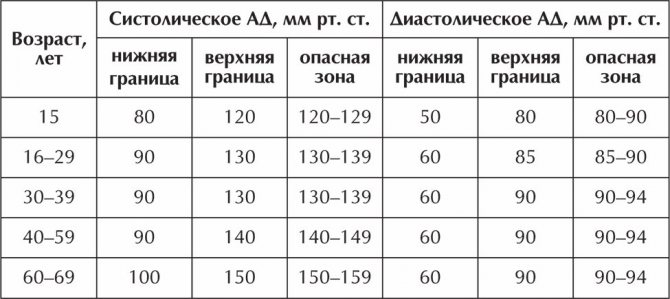
Pressure norm
If after rest the indicators do not return to normal, and the young man becomes dizzy and unwell, it is recommended to reduce the intensity of training and check the condition of the cardiac system. Perhaps the young man is developing an initial degree of hypertension.
What to do if, when measuring pressure, the tonometer readings were 115 to 75 mm Hg. Art.? Provided that the person is hypertensive, this may mean an overdose of antihypertensive drugs or a decrease in the force of contraction of the heart muscle. If the numbers continue to decline, the person is at high risk of developing heart failure or ischemic stroke. If a person is normo- or hypotensive, then these indicators do not bring him discomfort and do not cause him to feel unwell.
Pressure numbers of 112 over 60 suggest paying attention to the diastolic indicator. For hypotensive people, this is a normal value, as well as for adolescents who have physiological vascular hypotonicity. A decrease in the diastolic limit to 60 or lower with a rapid pulse should alert you, since it indicates increased work of the heart, which does not lead to the desired result.
Indicators corresponding to 115 to 65 or 118 to 70 can be considered the norm if a person’s working pressure is 120\80 or fluctuates by 5 units in one direction or another. But if the working pressure corresponds to 135-140\85-90, then a person feels uncomfortable at such pressure; for him, low readings may indicate the development of pathologies in the body.
What does 110 to 90 mean?
After measuring the pressure, the indicators indicate different phases of the heart:
- The upper value, also known as 110, is systolic pressure, indicating the force at which the heart pushes blood through the arteries.
- Lower pressure, also known as 90, is diastolic pressure, indicating the tone of the heart muscles in relaxed moments.
If we take the value of the norm, then there are permissible deviations that will be in the range of 91-139 by 61-89 mm Hg. Art. As soon as the specified norms begin to be exceeded, doctors diagnose it as hypertension, if the values are in the range of 140-180/110 or more, or hypotension, if the values are below 100/60.
A reading of 110 over 90 indicates diastolic hypertension in the earliest and mildest stage. It can be influenced by external factors, for example, worrying, stress, as well as poor nutrition and lifestyle. If the values are constantly fixed at 110 to 90, you will need to be examined by a doctor to conduct a full diagnosis, determine the causes and prescribe the correct treatment.
Some doctors believe that the increase in the lower value is often underestimated, so it is important to consider such a disease as diastolic hypertension. Especially when the indicator is 110 over 90 and is always accompanied by headaches and other symptoms of hypertension. All this negatively affects the quality of life.
Causes of pressure 110 to 90
When considering a pressure of 110 over 90, it is important to take into account the systolic value, because it is lower than normal. When a person’s indicator remains constantly at this level, then this is mild diastolic hypertension. If the value drops sharply from time to time, and the lower ones rise, then the cause may be improper functioning of the nervous system.
People involved in professional sports very often encounter blood pressure of 110 over 90. This condition is not a disease; it is more common after hard training. The value does not last very long and returns to normal after rest.
Alcohol may be the cause; it causes short-term disruptions. A similar condition appears during a hangover, because the body tries to remove alcohol from the blood and is intoxicated. Immediately after drinking alcohol, the value increases, but as the product is released, the indicator decreases. If a person consumes a lot of alcohol, then 110 to 90 is a sign of a hangover. If after alcohol the readings are 110/100, this is a dangerous value that requires hospitalization.
There are other possible reasons:
- Kidney diseases.
- Endocrine system disruptions.
- Impaired adrenal function.
- Atherosclerosis.
- Emotional and mental stress.
- Neurological disorders.
- Heart disorders.
- Excessive body weight of patients.
If a person has kidney problems, then the fluid is not excreted normally and is retained in the body. With swelling, jumps in indicators appear. In general, doctors believe that an increase in lower pressure is a kidney problem, and an increase in upper pressure is a problem with the heart.
If the functions of the adrenal glands or thyroid gland are impaired, patients also develop hypertension. For correct diagnosis, it is necessary to use ultrasound of these organs, which can exclude or confirm neoplasms.
If there is atherosclerosis, then initially only the lower value increases; as soon as the disease develops, the form of hypertension changes, and the upper values change.
Neurological disturbances, which are complemented by changes in pressure, speak of dystonia. A similar problem is characterized by impaired functioning of the nervous system, with exhaustion, hormonal changes and chronic diseases.
In case of stress, anxiety or fear, the indicators will change for a short period. This also includes ordinary fatigue and excitement. As a rule, the problem occurs in people who work a lot or are often nervous or sleep poorly.
Reasons for women
In women, a pressure of 110 over 90 often indicates hormonal imbalances or changes. Short-term changes can occur during stress, as well as during menstruation. Other reasons include:
- Strict diets using 1-2 ingredients.
- Pregnancy. In this case, you need to be examined by a doctor, since gestosis or other abnormalities or kidney disease are possible.
Causes in the elderly
For older people, blood pressure is 110/90 mmHg. Art. may be caused by the following reasons:
- Incorrect use of antihypertensive medications.
- Atherosclerosis.
- Kidney failure.
Treatment can only be carried out after diagnosis by a doctor. You need to understand that at this age, blood pressure can cause serious consequences and cardiac dysfunction.
Reasons for men
As statistics show, the male half of the population has problems with blood pressure due to physiology. The main reasons are:
- Lack of mobility.
- Excess weight.
- Frequent drinking.
- Tobacco smoking.
- Heart pathologies.
- Frequent stress.
In addition to the causes, it is important to know the main symptoms of the pathology, which will allow you to promptly identify the disease and take the necessary measures.
The main symptom of diastolic high blood pressure is headaches. With such indicators, the pain occurs in a circle, has a girdling character, and aching, squeezing sensations are possible. Against the background of the problem, the heart rate always increases. In addition, possible other characteristic symptoms:
- Dyspnea.
- The appearance of cloudiness, “goosebumps” in the eyes.
- Dizziness.
- Nausea.
- Chills.
With headaches, nausea may occur, which after a while is replaced by vomiting. After this, the patient's condition improves, since the lower threshold decreases for a short time, but rises again.
Failures lead to general weakness and loss of strength, and pulsating sensations in the ears are possible. Patients often experience paleness of the skin caused by a lack of oxygen. It simply cannot reach the organs and tissues in the proper amount. Often people develop tachycardia against the background of high lower pressure. It is accompanied by chest pain of a compressive nature.
If the problem is hidden in neurological disorders, then bradycardia occurs. The disease appears extremely rarely, but is not excluded. Doctors can accurately determine the causes and describe the characteristics of symptoms. Self-treatment is prohibited, because you must first make a comprehensive diagnosis of the body.
Blood pressure is 110 over 80: what does it mean and is it normal, as well as heart rate indicators and what to do?
Pressure 110/80 mm Hg. Art. is considered absolutely normal, but why is the upper systolic pressure slightly below the standard? In this article you will find answers to all questions regarding blood pressure fluctuations.
What do these indicators mean?
Doctors believe that pressure readings of 110/80, depending on the individual characteristics of people, are quite normal for some, while for others they indicate health problems. To know for sure whether to go to the hospital or just get more rest, you need to figure out for whom this pressure is normal and who should see a doctor.
For expectant mothers
According to doctors, blood pressure of 110/80 is quite normal for pregnant women and there is absolutely no reason to worry about the health of the mother and the unborn child. Such indicators should cause concern in the early stages of pregnancy, since they may indicate incipient hypotension.
For adults and seniors
The normal value for people over 60 years of age is 135/90 mmHg. Art. But older people very often suffer from hypertension, so if the pressure suddenly drops sharply to 110/80, you need to pay attention to this and consult with your doctor.
For children and teenagers
In newborn babies, blood pressure should not exceed 80/50 mm Hg. Art. The older the child gets, the higher these indicators grow, reaching the generally accepted norm by the end of puberty. Therefore, a reading of 110/80 in children should not worry parents.
Symptoms
In rare cases, the pressure is 110/80 mmHg. Art. accompanied by drowsiness and loss of strength without other, more serious symptoms.
But hypertensive patients with such pressure experience the following symptoms:
- difficulty breathing;
- tachycardia;
- sweaty palms;
- mood lability;
- lack of coordination;
- migraine, dizziness;
- tinnitus;
- jumping spots before the eyes;
- persistent fatigue;
- fainting;
- menstrual irregularities in women.
Causes
The reasons for changes in blood pressure can be very diverse.
In adults
- stress;
- overwork;
- use of diuretics or antihypertensive drugs;
- diseases of the endocrine and nervous systems;
- increased sensitivity to changing weather conditions;
- lack of sleep;
- excessive physical activity.
in pregnant women
- hormonal surges;
- stress;
- blood loss;
- prolonged dehydration;
- lack of sleep and fatigue;
- hypoxia;
- malnutrition;
- diseases of the cardiovascular system;
- gastrointestinal pathologies;
- disorders of the adrenal glands and thyroid gland;
- allergic reactions;
- infectious diseases.
in children and adolescents
- birth injuries;
- genetic predisposition;
- increased mental stress and stress;
- hypovitaminosis;
- unbalanced diet;
- insufficient immunity.
There are permanent and periodic causes of hypotension:
- permanent: heredity; metabolic disorders; heart disease; pathologies of the endocrine system; traumatic brain injuries.
- periodic: lack of oxygen due to being in a stuffy room; alcohol intoxication; excessive physical activity; dehydration; acclimatization.
heart rate values
To correctly assess the condition of a patient with a blood pressure of 110/80, healthcare workers must take into account the pulse rate:
- pulse 100 or higher: a sign of vegetative-vascular dystonia or neurological disorders. When it occurs, you should be wary of headaches, shortness of breath, weakness, nausea, lack of coordination, and decreased attention;
- pulse 90: possible pathologies of the thyroid or pancreas, due to the use of certain medications, abuse of caffeine, alcohol, tobacco;
- pulse 80: is normal for people over forty years of age or teenagers; for other age groups it is also not dangerous;
- pulse 70: ideal myocardial contraction rate;
- pulse 60: lower limit of normal.
What to do with such indicators?
If a person's working blood pressure is just above 130/90 and suddenly drops to 110/80, it can be adjusted independently. A cup of coffee or strong black and always sweet tea, a piece of dark chocolate, a Citramon tablet will help.
However, if you feel a deterioration in your general condition, then, in all likelihood, you cannot do without treatment. Seek advice from a cardiologist and neurologist - after an appropriate examination, they will prescribe treatment, if necessary.
Physiotherapeutic procedures can also normalize blood pressure. They include electrophoresis, ultraviolet phototherapy, massage.
In addition, the following will help maintain normal blood pressure:
- physiotherapy;
- a complete diet;
- walks in the open air;
- sufficient sleep;
- rejection of bad habits;
- control over emotions and stress.
In addition to all of the above, in order to generally strengthen the body, you can use herbal preparations containing:
- ginseng;
- Eleutherococcus;
- hawthorn;
- Schisandra chinensis.
The use of traditional medicine is not recommended without prior consultation with your doctor.
If minor hypotension bothers the patient, and herbal remedies and lifestyle adjustments do not lead to the desired result, the doctor may prescribe the following medications:
- Glycine or Glycised;
- Caffeamine;
- Piracetam;
- Encephabol;
- Midodrine;
- Cinnarizine.
All of them stimulate the central nervous system, so they are not available without a prescription. While taking these medications, you should avoid excessive physical exertion, taking hot baths and visiting saunas.
To avoid unwanted side effects, self-medication is strictly prohibited.
Treatment of low blood pressure in expectant mothers
Vascular tone stimulants can cause uterine contractions and premature labor. Therefore, expectant mothers should balance their diet and drinking regime, walk more in the fresh air, and engage in feasible physical activity.
Treatment in old age
The following techniques will help older people slightly increase arterial hypotonicity:
- resorption of table salt crystals;
- a cup of freshly brewed coffee;
- a piece of bread with honey and cinnamon.
To prevent hypotension, it is recommended:
- monitor the amount of fluid you drink;
- do regular massage, rub your palms and feet;
- to refuse from bad habits;
- monitor your salt intake.
And also read on our website what to do if your blood pressure is: 100 over 50, 100 over 60, 110 over 50, 110 over 70?
You can find out how to normalize blood pressure in the video below:
Conclusion
If the pressure is 110/80 mmHg. Art. appeared against the background of stress, overwork, etc., then there is no need to worry - after a while it will return to normal on its own, without medical intervention. However, if you feel anxiety, discomfort and deterioration in your general condition, you should immediately go to the hospital.
Source: //prodavlenie.online/izmerenie-ad/znachenie-pokazatelej/davlenie-110-na-80.html
Why is pressure 110 over 90 dangerous?
Many doctors with a diagnosed pressure of 110/90 mm Hg. Art. indicators are classified as maximum permissible standards that do not need adjustment. But there are some symptoms that will require mandatory medical intervention:
- Increased heart rate up to 100 beats/min.
- The pain in the head is severe, aching in nature.
- Constant nausea followed by vomiting.
- Feeling of anxiety.
- Cold sweat.
- Unpleasant sensations in the chest area.
- Uneven, intermittent breathing.
- Dizziness, tinnitus.
- Discharge of blood from the nasal cavity.
The described symptoms may indicate serious problems with the functioning of the entire body, when urgent medical attention is needed.


